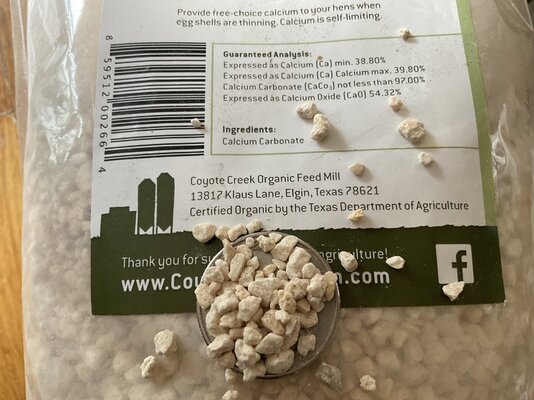- Thread starter
- #31
Katanahamon
Songster
- Jun 25, 2021
- 590
- 1,432
- 186
No, instead I want to thank you. If I’m wrong, call me out. I’m not going to insist on being right..my error was wanting a quick fix to my arguments and not reading further than seeing my own viewpoint validated. I’m wrong, so, I’m sorry if I got snarky, it’s not worth it. I’ll bet you have a buttload more experience with chickens than I do, and I want the benefit of that, that’s why I came to this site. Whatever I’ve said that’s offensive to you, I’m genuinely sorry. I’m a science guy..if there’s information I lack or something that changes then I want to change too. Have a great day.."Flame Photometry" Its a physical and chemical process including disolving in various acids which transforms the original specimen, allowing its total calcium to be determined by way of the calcium oxide product created during the transformation proceses when then exposed to flame and the wavelengths of emitted light are then recorded.
Yes, your quote is from this source. Keep reading.
QUOTE:
The study conducted by Smith and Wright (1962)[17] in Crassostrea virginica was used as guideline for the present study. In the present study, among the chemical constituents analyzed like Calcium, Carbon, Sodium, Magnesium, Sulfur, Strontium and Moisture, Calcium and Carbon were present in high concentrations while all the remaining constituents were observed at low values below 1.5%. The concentration of Calcium carbonate in the shell of Crassostrea madrasensis constituted 91.36% by weight of the shell. This was lower than the value in Crassostrea virginica by Smith and Wright (1962) who recorded it at 95% by weight of the shell.
Smith and Wright (1962)[17] found that the Calcium (CaO) content in the shell of Crassostrea virginica was 54.6%. In the present study for Crassostrea madrasensis, the percentage concentration of Calcium (CaO) in the shell has been recorded at 47.49%, which is a 7.11% variation between the two species. Concentration of Total Carbon at 43.87% was observed to be very close to that of C. virginica at 43.5%. The concentration of Sodium (Na2O) in C. virginica was 0.32%, while in this study for C. madrasensis it is 1.12%. The analyzed value of Magnesium (MgO) in C. madrasensis shell was 0.619%, which is comparatively larger than the previous study
According to Smith and Wright (1962)[17] the Sulfur (SO2) and Strontium (SrO) of C. virginica are 0.16% and 0.12% respectively. But for C. madrasensis, it was observed as 0.403% and 0.02% respectively for these two elements. The concentration of moisture showed a slight variation between the two species, 0.58% in C. virginica and 0.804% in Crassostrea madrasensis.
/QUOTE
The Potential Use of Oyster Shell Waste in New Value-Added By-Product (at page 3)
QUOTE
he cleaned oysters can be reused in several applications. The principal component (approximately 96%) of oyster shells is calcium carbonate (CaCO3), which can be used in various sectors; for example, the construction industry, as an aggregate of limestone for cement, and even the pharmaceutical industry, as a calcium-enriched supplement [4,13].
/QUOTE
Etc...
That's a might fine virtual shovel you have there, perhaps you should stop digging?




